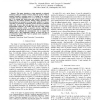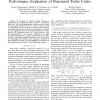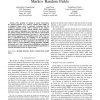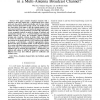116
Voted
CISS
2007
IEEE
15 years 24 days ago
2007
IEEE
This paper introduces a robust approach to stochastic multi-hop routing for wireless networks when the quality of links is modelled through a reliability matrix R. Yielding to the ...
116
Voted
CISS
2007
IEEE
15 years 2 months ago
2007
IEEE
Abstract –In this paper, a new problem, consensus estimation, is formulated, whose setting is complementary to the well-known CEO problem. In particular, a set of nodes are emplo...
145
Voted
CISS
2007
IEEE
15 years 2 months ago
2007
IEEE
– The process control industry has shown great interest in implementation of low cost, low power wireless sensor networks. Such networks are much easier to deploy and reconfigure...
81
Voted
CISS
2007
IEEE
15 years 2 months ago
2007
IEEE
— In this paper, we present a simple technique to approximate the performance union bound of a punctured turbo code. The bound approximation exploits only those terms of the tran...
115
Voted
CISS
2007
IEEE
15 years 2 months ago
2007
IEEE
— Flexible distribution of data in the form of quantum bits (qubits) amongst spatially separated entities is an essential component of envisioned scalable quantum computing archi...
135
Voted
CISS
2007
IEEE
15 years 4 months ago
2007
IEEE
The problem of routing of sensor observations for optimal detection of a Markov random field (MRF) at a designated fusion center is analyzed. Assuming that the correlation structur...
88
Voted
CISS
2007
IEEE
15 years 4 months ago
2007
IEEE
116
Voted
CISS
2007
IEEE
15 years 4 months ago
2007
IEEE
Abstract-Joint subcarrier, power and rate allocation in orthogonal frequency division multiple access (OFDMA) scheduling is investigated for both downlink and uplink wireless trans...
103
Voted
CISS
2007
IEEE
15 years 4 months ago
2007
IEEE
This paper considers broadcast channels with L antennas at the base station and m single-antenna users, where each user has perfect channel knowledge and the base station obtains c...
101
Voted
CISS
2007
IEEE
15 years 4 months ago
2007
IEEE
Distributed space-time-block-coding (Dis-STBC) achieves diversity through cooperative transmission among geographically dispersed nodes. In this paper, we present a powerefficient...




